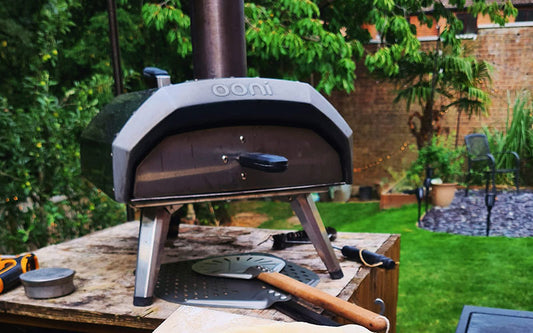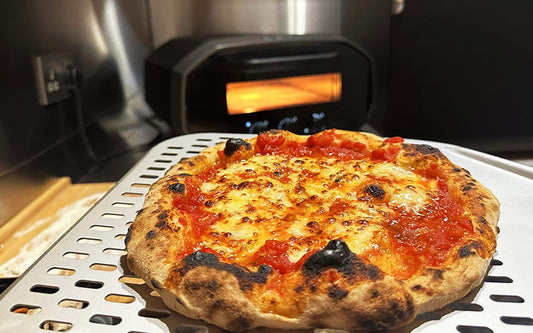Did you know that every year, around 502805 pizzas are ruined due to the use of subpar bakeware? Okay, I might have made up the number, but the fact remains – incorrect bakeware can seriously affect the quality of the finished pie.
When it comes to the best bakeware for baking pizzas, thick pizzas stones are certainly one of the easiest choices for pros and home cooks alike. Thanks to their high thermal mass, thick pizza stones (0.6 to 1 inch) retain heat longer than regular pizza pans.
That’s not it. These bad boys also result in a crispier crust by absorbing moisture from the dough. Some would also argue that pizzas baked on a stone taste different (in a good way) from pizzas baked on a pan or steel.
In this article, I’ll cover everything from the best materials for pizza stones to how to properly care for and use them. Get ready to transform your pizzas from mediocre to mouthwatering with the help of a trusty thick pizza stone. So keep reading.
Does a Thick Pizza Stone Make Any Difference?
Wouldn’t buying an extra thick pizza stone be an overkill? No. Not really. When it comes to pizza stones, thicker is always better. Although thinner pizza stones are more portable and easier to store, they simply do not offer the same level of performance and durability as thicker stones.
Thicker stones are more effective at retaining and transferring heat, as well as being more durable and versatile. This is because higher thermal mass helps maintain a consistent cooking temperature for longer periods of time.
In general, pizza stones are not, ironically enough, not tough as a stone. They are made of ceramic, have a porous surface, and are susceptible to thermal shock.
Next Read: Easy Techniques for Keeping Your Pizza From Sticking to the Peel
Putting a cold stone in a hot oven or manhandling can cause it to shatter. So, it makes total sense to purchase the thickest stone you can find to minimize the risk of cracking.
How Thick Should a Pizza Stone Be?
Most budget pizza stones are 0.4-0.5 (10-12mm) inches thick, while thicker stones are anywhere from 0.6 to 1 inch thick (15-25mm)
But if you are a serious baker and use a wood-fired oven, you should get yourself an extra thick (1/2 to 1-inch) pizza stone. However, thicker stones are considerably heavier and take longer to preheat. So, if portability is #1 priority and you would be baking only once in a while, then go for a 0.4-0.5 inch budget stone.
Maximum Recommended Temperature Based on Pizza Stone Thickness
Pizza stones have a thermal mass to them. This means that the stone itself stores heat and keeps it inside the oven for a long time. So, if you are using a thick pizza stone, it will take longer for your pizza to cook.
1. OONI BAKING STONE HIGHLIGHTS
The thicker the stone is, the longer it will take your pizza to come out of the oven (and vice versa). Below I have outlined the maximum recommended for various thicknesses of the pizza stone to help you make an informed guess.
Note that these are ballpark figures, and every oven has its quirks. Also note that it is important to check the manufacturer’s recommendations for the specific pizza stone you are using, as the maximum temperature may vary.
Next Read: A Slice of the Facts: How Many Calories are in Pizza?
It is also important to note that the temperature of the oven or grill should be properly preheated before placing the pizza stone inside. Allowing the stone to heat up gradually along with the oven or grill will help to prevent thermal shock, which can cause the stone to crack or break.
| Thickness (in) | Temperature (°F) |
|---|---|
| 0.4 | 485 |
| 0.5 | 500 |
| 0.6 | 600 |
| 0.5 | 850-950 |
| 1 | 1000-1200 |
Soapstone vs. Other Types of Pizza Stones
Soapstone is a naturally occurring mineral known. It has nonporous material and antibacterial properties, making it better for countertop cooking. Soapstone pizza stones also hold heat better than other types of natural stone, allowing them to generate a crispy crust for your pizza.

Furthermore, soapstone does not absorb any residue from the food prepared on it, so it can easily be cleaned with soap and water. In comparison, ceramic pizza stones are formed of clay which allows them to absorb moisture and generate a crispy crust for your pizza.
However, they can sometimes cause the pizza to stick and need to be preheated for at least 15 minutes before use.
Cordierite pizza stones are more durable. But they require more care when cleaning.
In short, soapstone is the best material for a pizza stone due to its superior thermal properties. It is also better suited for bbq grills than ceramic or cordierite stones.
5 Benefits of the Thick Pizza Stone
As you can see, the thickness of the pizza stone is an important consideration as it affects the cooking speed and uniformity. To give you an even better understanding, below I have summarized the key benefits of going for the thickest pizza stone you can find:
1. Faster Heat Transfer
Because a thick pizza stone is made of a dense, heavy material, it can transfer heat more quickly and evenly than a thin stone. This means that your pizza will cook more evenly and consistently, with fewer hot or cold spots.
2. Better Heat Retention
A thick pizza stone is able to retain heat for longer periods of time than a thin stone. This can be beneficial when baking pizzas. This is especially useful if you are cooking multiple pizzas in succession. The stone will remain hot enough to cook each pizza to perfection without the need for preheating between pizzas.
3. Shorter Baking Time
Due to their impeccable heat retention and deflection ability, thick stones can shorten the overall baking time. This can be especially useful if you need to turn out multiple pizzas in a short amount of time.
4. Crispy Crust
A thick pizza stone can also help to create a crispy crust on your pizzas by evenly distributing heat and drawing moisture away from the dough. This can result in a perfectly cooked, crispy crust that is both crunchy and flavorful.
5. Less Prone to Damage
Last but not the least, using a thick pizza stone is that it is less prone to damage than a thin stone. As thicker stone is made of a denser, heavier material, it is less likely to crack or break when exposed to high heat or thermal shock.
This makes it a more durable choice for long-term use, as it is less likely to need replacing anytime soon.
Next Read: Overproofed dough: a common mistake to avoid
Moreover, a thick stone is less prone to warping or bending over time. Bending occurs with thin stones due to the constant exposure to heat. So a thick stone will maintain its flat, even surface for longer.
How to Use a Thick Pizza Stone?
There’s no special technique required to use a thick pizza stone. All pizza stones, irrespective of the thickness, require you to preheat them in the oven before baking your pizza. If you are new to using pizza stones, follow the instructions below to whip up delicious pizzas every single time:
- Set your oven to its highest temperature (usually 450-550 degrees on domestic ovens)
- There’s no need to season your pizza stones unless specified otherwise by the manufacturer. If seasoning is recommended, lightly brush the stone surface with vegetable oil.
- Place the stone on the lower rack and let it preheat for an hour. If it’s an extra thick stone, add 10 more minutes. Or simply follow the manufacturer’s instructions for your specific model.
- Once preheated, sprinkle some cornmeal or semolina flour on the stone (avoid flour, as the finer grains can remain trapped in the stone for ages).
- Transfer the dough onto it and bake. In brick ovens, it hardly takes 90 seconds to bake a pizza to perfection. Regular ovens can take anywhere between 6-12 minutes, depending on the oven temp and stone thickness.
- Don’t remove the stone immediately after baking. Turn off your oven and let the stone cool down in it. Removing it immediately may cause thermal shock, causing it to crack.
Related FAQs
How do you clean a dirty pizza stone?
To clean a dirty pizza stone, first, allow it to cool completely. Then use a spatula or brush to remove any food scraps.
For stubborn stains, create a paste of one part baking soda and one part water and apply it to the stone. Then rinse with hot water and dry thoroughly.
How long does it take for a pizza stone to dry?
It typically takes 1-2 hours for a pizza stone to dry. However, the exact time may vary depending on the thickness of the stone.
Can you use a pizza stone on a frozen pizza?
Yes, you can use a pizza stone for reheating a frozen pizza without thawing. Just place the frozen base on the cold stone and put it in a cold oven. Use the ridged side of the stone as it provides less surface area for potential thermal shock.
Ideally, you should use a thicker pizza stone for this purpose and preheat it properly before placing a frozen pie on it.
What is the best material for pizza stone?
Although ceramic stones are more common, stones made of cordierite, soapstone, and composite materials are better at distributing and transferring heat and are more hard-wearing as well.
How thick is the OONI pizza stone?
Ooni pizza stones are available in two different thicknesses, 0.4 and 0.6 inches. Both are suitable for baking pizzas, and both can be used with either gas or electric ovens.
However, the 0.6″ stone is more durable than the 0.4″ version, so it’s worth considering if you plan to use your stone on a regular basis.
Conclusion
In conclusion, thick pizza stones are superior to thin ones because they retain heat better, produce more evenly cooked pizzas, and are less prone to breaking.
If you’re in the market for a new pizza stone, opt for a thick one to get the best results. At the end of the day, the best pizza stone is the one that meets your needs.
-------------------------------------------------------------------------------------------------------------
Affiliate Disclosure:
The links provided may earn us a small commission at no additional cost to you if you choose to purchase the recommended product. This support allows our research and editorial team to continue providing high-quality recommendations. As a participant in the Amazon Services LLC Associates Program, an affiliate advertising initiative, we are able to earn advertising fees through providing links to products on Amazon.com. Please rest assured that we only recommend high-quality products.






